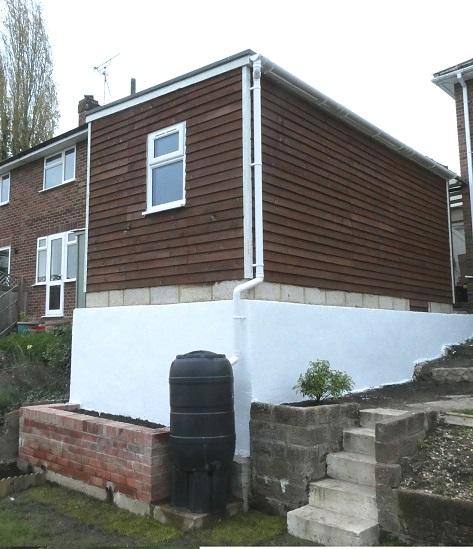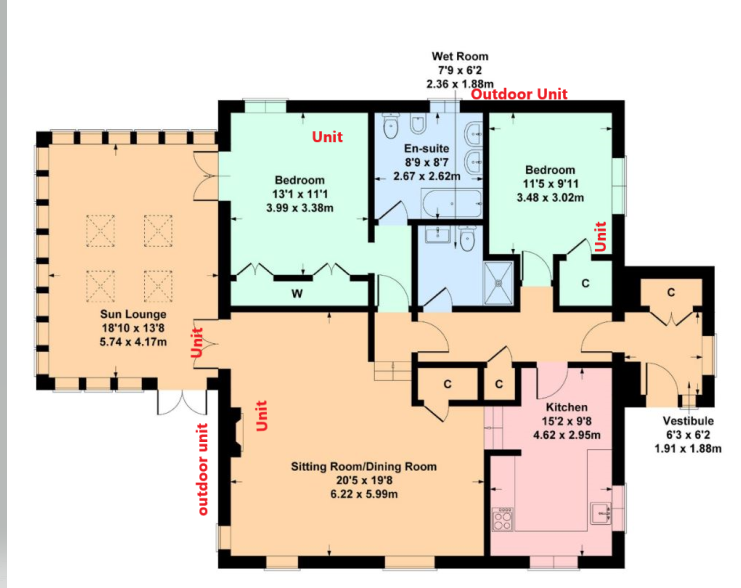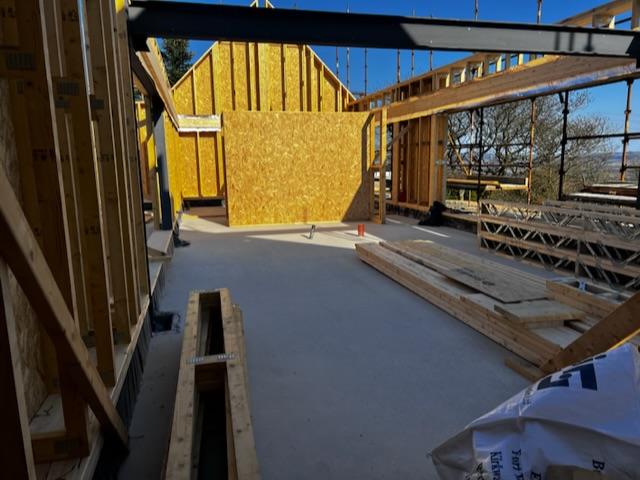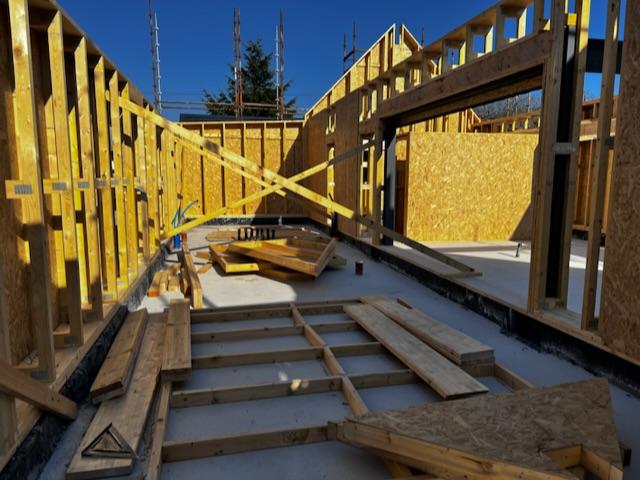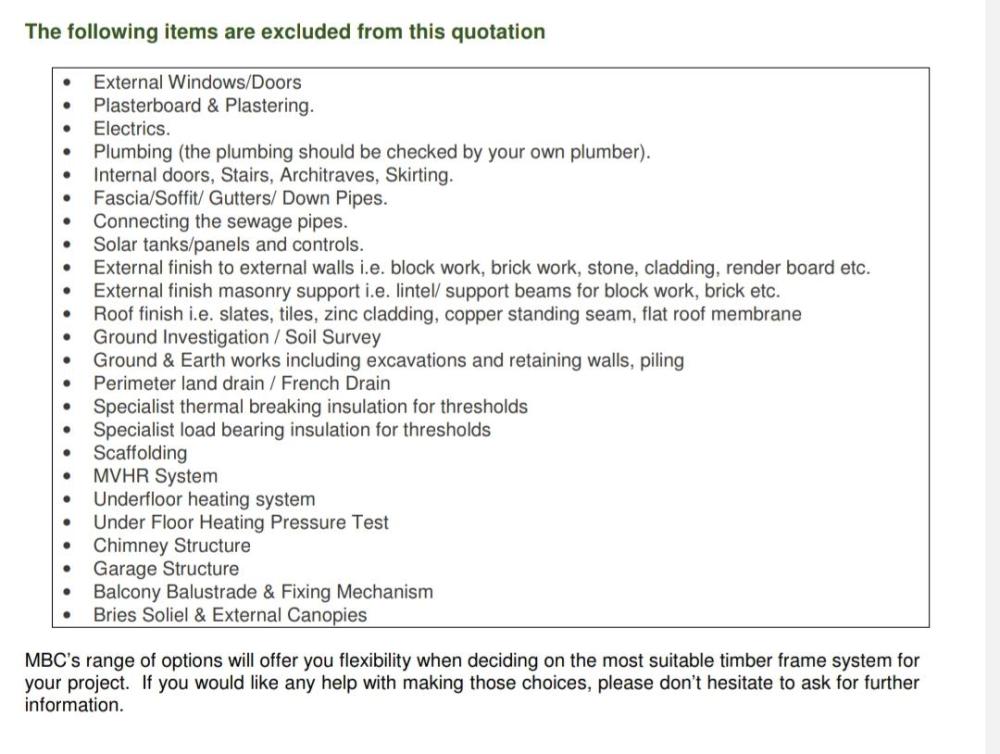Leaderboard
Popular Content
Showing content with the highest reputation on 04/22/23 in all areas
-
3 points
-
Yes Ruxley indeed. The number of times I have heard this quoted by lawyers, either in seminars or real cases. The main point they were making was that this judgement seemed ludicrous but was strictly what the law stipulated. In Ruxley, if I remember, the minimum depth of the pool was even stressed as a fundamental requirement, yet the ruling was that it was not so important. Logically if your windows end up 1% smaller*, I can see the judgement being for a credit of 1% of the contract. * smaller than what? We don't have the drawings or spec. The last thing ggc needs is to be famous (and impoverished) for the case of ggc v Bloggs Glazing. I'm not saying for a moment that the glazing co is blameless. Just to stress...is it such a big deal? And don't get legal. (I think there was another swimming pool case where an Olympic pool was short between touch pads. That was however judged to be crucial.) i Irrelevant to ggc of course. We should have a button for " transfer discussion to new topic".2 points
-
When we're they added or we're they original to the house? If added later the porch and garage might not even have needed planning permission. Might be permitted development... https://www.planningportal.co.uk/permission/common-projects/porches/planning-permission https://www.planningportal.co.uk/permission/common-projects/outbuildings/planning-permission If they did need planning permission and it wasn't obtained the time limit for enforcement action is normally 4 years (unless its a breach of a planning condition or a change of "use class", in which case its 10 years). Back in 2006 my council allowed access to the paper planning files. Don't know if they still do. Last I heard you had to ring up and make an appointment the see files for an address or specific planning ref number. If you don't get anywhere I would see if your solicitor will let you reply with something like.. "The porch and garage we're constructed before we purchased the property 8 years ago. The planning status is unknown. It is possible they were constructed under Permitted Development Rights but the buyer should satisfy themselves that this is the case. If planning permission was required and not obtained it is possible that it is too late for enforcement action to be initiated, but again the buyer should satisfy themselves that this is the case."2 points
-
When we purchased our plot in early 2020, I decided to do the conveyancing myself (as I'm basically a tight-arse). I didn't want to pay a solicitor to take months to do something I could easily do myself. Having completed that successfully, the purchase was finalised, and I then filled in the SDLT form and sent off a cheque for the tax that I believed was due. At that point, being aware that this was a second property, I calculated that we owed SDLT at the higher rate, so £5,000 on a plot purchased for £150,000. Skip forward to September 2022, perusing on Buildhub I discover that a building plot is not necessarily a residential property for the purposes of tax. News to me! I went back to HMRC's website, and learned that if the plot was non-residential, then the tax I owed would have been £0 (as the threshold starts at £150,001). As the plot we bought had previously been an agricultural field, prior to the vendor having obtained planning consent, then it was indeed non-residential for tax purposes. I contacted HMRC's helpline to discuss, and the chap I spoke to kindly explained that I could write in and ask them to repay me. I'm not sure whether he was aware or not, but at that point there was actually 0% chance of HMRC repaying us. The rules said that I had only 12 months from the date of completion (June 2020) to revise my SLDT submission. After that, tough luck. Any incorrectly paid tax would not be repaid. HMRC replied to my first letter, rejecting my request on the grounds that I had not quoted the piece of law I was relying on to ask for it. I then spent an entire weekend researching caselaw on situations such as mine. What an exercise in disappointment that was, to put it mildly. I read every single published judgement on SDLT cases for the previous 5 years, as well as the relevant regulations themselves, and concluded that there was simply no basis for me to persuade HMRC to repay us. I was crestfallen, and had to admit to HWMBO that I had gifted £5k to the Treasury out of my own ignorance, and my unwillingness to pay legal fees. Still, I decided that it was worth one final try, and I sat down in January to write the mother of all letters to try to persuade HMRC to repay us. I explained my mistake, cited the regulations, and asked if they could exercise discretion to allow a late amendment to the SDLT1 form on the grounds that they had themselves checked the form at the time and had not identified my error, despite there having been enough information on the form for them to have reasonably suspected that the property was not residential. I said that if they would not do that, would they please consider opening an enforcement case against us so that they could review whether we had paid the right amount of tax, and calculate for themselves what we owed (which was the only legal route that would allow them to revise the SLDT1 form beyond the time limit). Then I went for the heartstrings, saying that we really couldn't afford to gift this money to the Treasury, and if they could please see their way to reimburse us, we would be eternally grateful. A couple of weeks ago HWMBO found a credit in his bank account of £5089.00 with a reference of 'HMRC SDLT'. They had not only repaid us, but added interest for the time they had had the money. They haven't written to us to say why they decided to do this, so I've no idea which part of the letter was effective, but it feels churlish to question it. A very salutary lesson in there for me. And perhaps for some of you too.1 point
-
I've been trying to work out A2A sizing as the one installer that's come back to me hasn't been able to come up with a workable solution with two outdoor units. I think it's entirely possible but my calculations are giving me lower requirements. I've had a read through this thread but would appreciate any input on my calculations so far. I've used a basic online calculator for BTU (it doesn't take window U value into account or underfloor insulation so it's possible our requirements are lower than the figures noted) Requirements 4 indoor units / preferably 2 outdoor Living room. Currently heated by 2 x 3.4 kWh storage heaters. Room size 105 m3. BTU 13586 / 3979w Bedroom. Rarely heated but 2kWh panel was sufficient over the winter. Room Size 40m3. BTU 4794 / 1404w Bedroom 2. Office room / spare bedroom. North facing room which gets very cold without heat. Room Size 36m3. BTU 4285 / 1255w SunRoom. Would benefit from some cooling in the summer months. Generally we do not use this room over winter but there will be the odd occasion (Christmas dinner) where we need to heat it. Room size 68m3. BTU 11517 / 3373w. The bedrooms I was thinking 1.5. The sundroom, 3.5 unit I think would be fine based on our use. The living room I'm unsure of as it does have an opening to the (unheated) kitchen but I thought 5kW unit would be sufficient. We are not planning to rip out the storage heating this year as will provide fallback if I get this all wrong. The installer was looking at 7kW in the sunroom, both bedrooms at 2kW and 6kW in the lounge. I did explain our use of the sunroom but I don't think that has been taken into account . Their rationale for 3 outdoor units is that putting additional units on a single external increases the refrigerant quantity into apparently unsafe levels. They've been back and forth with Daikin, Mitsubishi and Toshiba but doesn't seem to be getting clear answers so are recommending three outdoor unit as 9kW is going to be max capacity for one unit. I have to say I'm in the dark on this - I thought you just looked at the max capacity on the external and took concurrent usage into account. With my calcs we could put the sun room and the living room on one outdoor unit and the two bedrooms on another. With the house layout the living room would need to share with the sunroom otherwise we'd be looking at three outdoor units. I'm not sure how I should consider sizing the external units - do they perform better at particular loads? It's unlikely we'd be using both the sunroom and lounge room on full power for either heating or cooling. I was considering up sizing the external unit that will feed the two bedrooms in case we decide to put another unit in the hall. Would that have a detrimental impact on performance? Appreciate any input. Thanks * correction - bedroom unit on back wall beside outdoor unit1 point
-
If you have WiFi connected devices, like My Daikin A/C, then there's a scheduler that can be shared by multiple units. Investigate the smart options if available for the equipment you intend to buy.1 point
-
I'm convinced air-to-air has to be an answer here. Even if the government isn't willing to subsidize it! Generally more efficient (SCOP >5 in many cases) Usually less expensive, and can be done incrementally If you want to fully electrify, DHW can be a bit of a challenge, but there are options depending on individual circumstances.1 point
-
I think there are a good correlation, the typical boiler installation is around 80% efficient, the typical low temp weather compensation gas boiler efficiency is 110%, which is a big drop in running costs, but not many installs are complete so that advantage can be taken, instead the installer uses a Y plan or similar. Living in the sunny south also has some advantages, well insulated here means I only have my heating on for 5 to 6 months a year, instead of on most of year.1 point
-
Id be happy enough rigging something up for myself. Was one of the negatives I keep seeing mentioned but it will still be a massive improvement on our E7 storage heating so I'm good with that. I'm hoping the other two companies I approached will come back to me as I'm feeling a bit like the non expert advising the experts. Hopefully that will change with an on premise assessment and further refinements.1 point
-
No, that's a separate issue. Necessary I grant, but not the problem I'm trying to discuss/solve, namely that the transition to ashp isn't happening (and as things currently stand isn't going to happen) because it's too difficult, too expensive, and too disruptive in the way we currently do it.1 point
-
@Gill I've got Mitsubishi Electric - the Zen models though, one under your LNs. Can't complain at the kit and the outside units quiet most of the time - when working hard its just the fan blowing air creating any noise. Re the sunroom - if you use it at different times to the living room you can always undersize the outside unit a little since neither is on at the sametime. Honestly - I'd bow to your fitter experience at that point though - my fitter had a 'gut feel' 'professional experience' call it what you will re inside unit sizes vs. room sizes which pretty much matched my BTU calcs. The other part to be aware of - the inside units on multi split all come with remote controls - they work fine, but by default you end up with a time clock on each inside unit rather than central control. I didn't ask my fitter re wired controls - instead fancied the project myself - sourcing components directly for a fraction of the retail price. The Mitsubishi electric install and combination files are out there - sometimes on European or even Australian installer sites though. Google: MXZ-2F33-42_3F54-68_4F72VF_Combination_Tables.pdf (3.3-5.4kW outside) MXZ-3F54VF_Comination_Tables.pdf (5.4kW outside) MXZ-5F102VF Combination table.pdf (10.2kW outside)1 point
-
Looks good To keep in mind - indoor units connected to a single outdoor have to be in the same mode; You can have one on a mini split on heat while another is on cool - I think you took this into account already - i.e. bedrooms split from living. Power Where is the fusebox - ideally if you can get a separate circuit for the outside units (in my opinion - I am not an installer) its nicer/cleaner than tapping into a local ring/socket. Sizing 1.5 in bedrooms seems reasonable 3.5 in that living room would probably work - consider if you want a wall or floor unit - the floor units really pump out the heat - I've a 3.5kW indoor happily heating a large dining room/up the stairs and landing in my house. Starting point for the outside units is add up the kW of the indoor's attached to them. So very roughly (and I'm not an installer) a 5kW outside the bedrooms and a 10kW outside the living room. Depending on the manufacturer you can downsize by say 10-15% and the indoor units will get less heat/cool performance accordingly (search combination tables for rules on same) Sunroom The sunroom is the question mark for me - I read the cooling point - its going to push you from another 5kW to a 10kW - i.e. (again roughly) 1kW typical draw to double that. Depends entirely how you use it of course - but heating or cooling in an uninsulated (guess) space feels like it needs some thought. If you open the bedroom door and the sitting room door will enough cold air filter into the sun room for those few days it needs cooling? If you know the model you are likely to fit - try googling <model install pdf> <model combination pdf> etc... some of the detail docs are public. Ultimately you need to trust the installer but you can go in with some knowledge.1 point
-
I get your point, but if we self build we could be mortgage free. That’s the aim really. updating our current house would cost even more money (that we don’t have) and if we were to borrow more to do this our mortgage would increase even more. the most financially savvy thing to do (based on estate agent advice) is to split the plot and sell them separately (with pp for garden). However, we really love our location and our priority is to stay in our village. The housing stock in our village isn’t great so we feel this is the most affordable way of staying where we live and being mortgage free1 point
-
Just one year of data for me, but PV GIS estimate of 4.5MWh, is pretty close to our actual output of 4.26MWh. not looked at it on a monthly basis.1 point
-
1 point
-
I wouldn't worry. Pack it out with batten if you feel the need1 point
-
Why I like to monitor my own usage locally, and keep it to myself (except what I share on here). https://forum.buildhub.org.uk/blogs/entry/946-the-energy-meter-experiment/1 point
-
Sorry, no. My meter is set for single rate and there's no indication in the app that it would be able to group usage but it would cost you nothing to try it. There's absolutely no pressure to engage with the company once you've installed the app. so nothing to lose in trying it.1 point
-
As I understand it it is from the finished surface so you should be OK. Make sure you put the warning tape at the correct level above the cable, at higher levels as well, so directly beneath the slab if like and put it in ducting if you have some. If you are in Kent I can let you have a length as I have a bit left over.1 point
-
Yes fine - what’s the outer face of the dormer going to be ..?1 point
-
I have a couple of Ring stick up cams powered by Ring solar panels, so no power connection required. I moved my virgin internet router to my power hut before I demolished my bungalow. If your neighbours are friendly perhaps ask for temp Wi-Fi access until you get yours setup.1 point
-
This last week when it has been sunny but the air not very warm (cold east wind off the cold North Sea) our sun room warms up nicely and we just open the doors to let the warmer air into the house. I did think about ducts and fans to automate this, but the sun room is outside the "air tight" envelope of the house and hence outside the scope of the MVHR system. So any such duct would kill the air tightness of the house.1 point
-
Why is the dormer face only 100mm thick? Surely that won't contain enough insulation by modern standards. I would be asking your builder why is the wall plate so small?1 point
-
1 point
-
If the buyer doesn't like that reply you could consider applying for a Certificate of lawfulness on the grounds its too late to initiate enforcement action. Might take some time though.1 point
-
Have a search on here, someone did this or very similar not that long ago, thread contains lots of details1 point
-
You only need 50mm battens for downlights, if you select the right ones. The transformer comes seperate and will slip in the void and the lights are slimmer than that.1 point
-
😂 none of it down to me but all of it up to me to sort. It’s like a comet flying through space with an ever growing tail of stuff to fix extending out behind it.1 point
-
What a first week of my self-build (kit erection phase) Let me tick off the excitement: 1. Kit arrived ✔️ 2. kit fell off tele-handler ✔️ 3. I had a massive row with the company owner ✔️ 4. damage wasn’t too bad and all fixed now ✔️ 5. windows arrive a day early which no one was expecting same day as scaffolding going up. We debate what to do. I raise concerns about windows getting damaged kit company decide to off-load ✔️ 6. windows get damaged ✔️ 7. everyone denies it was them and they would all 100% own up to it if they did it ✔️ 8. i have a very calm discussion with company owner this time but he still threatens to stop all work. We kiss and make up ✔️ 9. he visits site and we agree damage repairable so window will be installed and igu replaced along with damaged cladding 10. Impatient portaloo driver drives down culvert. Portaloo company promise to get a manager to call me no one does. ✔️ However, in roughly four days the kit is up. Internal walling started and it looks beautiful so dead pleased.1 point
-
Well we are new to this site but this one thread alone has proved it's worth. We purchased our plot last November and paid the £4500.00 sdlt that our solicitor said we had to. Having read @Omnibuswoman thread we spoke to HMRC to confirm and have sent off for a refund (Plot @ £150K so 0%). When I requested a copy of the SDLT form we filled in originally from the solicitor and told him why we wanted it, there was no acknowledgement of having given us the wrong advice whatsoever! If we get the tax back (this is HMRC after all) there'll be a contribution to the site's running costs coming.....1 point
-
very interesting, how come the appeal judge who got it wrong and wasn't sacked after being proven wrong ? If he was a trade he most definitely would off! or is it public servants are immune from having any consequences for their actions ever. by the sounds of it months of wranmgling on the windows will knacker the build up, the front door on the other hand id 100% reject it and get a sheet of ply instead in the meantime if needs be.1 point
-
The case you are thinking of is probably Ruxley Electronics and Construction Ltd v Forsyth [1996] AC 344. In that case, some builders had agreed to construct a swimming pool with a diving area 7 feet 6 inches deep. The pool when constructed had a depth of only 6 feet. The cost of rebuilding the pool to the contractual depth would have been £21,560. But the trial judge, having heard the evidence, concluded that the pool owner did not have the intention of using the damages to reconstruct the pool. He found also that the residential property of which the pool formed part had suffered no diminution in value by reason of the lack of one foot of depth in the pool's diving area. Nonetheless the pool owner claimed the £21,500 as damages. The builders, on the other hand, contended that, on the facts as found, the pool owner had suffered no loss and the damages should be nil. The trial judge accepted neither contention but instead awarded the £2,500 expressed as compensation for "a loss of amenity brought about by the shortfall in depth" (see at p 363). The Court of Appeal [1994] 1 WLR 650 set aside the £2,500 award and substituted an award of the cost of rebuilding, ie the £21,560. The House of Lords, overturned the Court of Appeal’s decision and restored the trial judge's order. However, I think that case can be distinguished from the present situation, for the reasons below: @ggc is not intending on keeping the undersized windows, whereas Mr Forsyth intended to keep and use his undersized pool. There are differences between the utility of a swimming pool that is a little bit shallower than intended and windows that are a little bit smaller than intended. The latter will require additional remedial work to fix, will let in less light, and will end up giving a slightly different aesthetic. Perhaps these differences are subtle, I’m not sure.1 point
-
I assume you mean £3000/m2. If so that is a healthy budget. Ours probably cost about €1900/m2 pre covid once you factor in my labour, but that was beds dressed, walls painted etc etc. That's including VAT too so an equivalent pre covid cost in sterling might be about £1500/m2. MBC were about £390/m2 in 2019 but that excludes quite lot. With the twinwall frame they have the best thought out system I know of however.1 point
-
If you have Wi-Fi , the ring stick up camera is good value. decent imagery, motion notification, verbal warning of coming into selectable section zones. Takes a few minutes to set up on the app and away you go, under£4 monthly fee1 point
-
Having spent 20yrs working in sales in the motor trade, working with some very high end brands, I appreciate that attention to detail is of paramount importance. Nice to get some opinions that counter the liability argument. Verbal was always something that i adhere to, wysiwyg and all of that. As @Dave Jones says Third one’s a charm!1 point
-
You will not need any electrical layout drawings for a Bldg Reg application. At completion you will need to hand over a copy of your electrician's certificate to the BCO. Be aware Part M relating to disabled use sets minimum and maximum heights for switches, sockets etc but layout within rooms is not controlled. Ventilation in dwellings is controlled by Part F Volume 1. The requirements are performance based requiring a certain number of air changes etc. They are not so concerned about routes of pipes and layouts of inlets/outlets in rooms. Have a look at paragraphs 1.67 through to 1.83 in the Approved Document to Part F. They give guidance on how the Regs control MVHR. The important bit is the commissioning and testing when complete as again you will need to provide a copy of the test certificate. So a performance specification is probably more useful to show compliance than a layout plan. The BCO doesn't need to see the UFH layout plan. There are some fairly basic requirements for UFH in Part L Volume 1 Paras 6.28 to 6.32 but the layout is more a design matter for the heating engineer to meet your heating requirements. The layout ought to be kept though and added to the information on the system as part of the "handbook" for future owners. Remember if information isn't available prior to the building reg application being submitted it can always be added when available (obvioulsy it's more helpful if that's before the work is carried out). If the BCO thinks that something critical to showing compliance is missing then they'll ask for it.1 point
-
In my experience if you are an unsecured creditor in a liquidation you are getting nothing. We could not even get things like tiles left over as spares. In fact I had to resort to threats to get spare house keys back. I also tried to get information on warranties that were put in place by the contractor and got zero response. They only time I got any real communication from the liquidator was when they came after us for money.1 point
-
Three nos They tend to be quite generic Bit of a tick list Ours mentions a gas boiler There’s no gas Structual engineers tend to be cheaper than using an Architect1 point
-
As others have said above my builders just used whatever was leftover at the end of the day, watered it down chucked it on the floor and brushed it across the blocks (FOC). Many months later I needed to move a soil pipe only a couple of blocks across from where it was originally placed , ended up having to destroy the blocks with a kango and lump hammer to get them out .1 point
-
Because judges "don't get it wrong. They make a decision based on the law. Then at appeal that may be reversed and at reappeal it may be reinstated. Common sense does not necessarily have anything to do with it. Try reading the judgments. If it was simple then there would be no need for juries or judges.0 points



